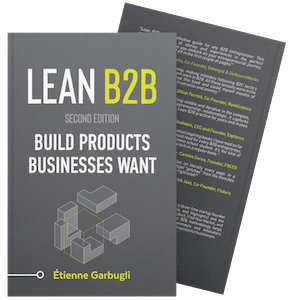There are good and bad ways to do B2B customer development interviews and, unfortunately, to the untrained eye, they look very similar. Here are 16 key interview pointers to help you conduct valid interviews and improve your customer interview techniques:
Key Tips for B2B Customer Interviews
- Learn to stay quiet: The best interviews are 90% listening and 10% talking. Don’t feel like you have to talk, or fill silences. If you really need to, ask a clarifying question: “Sorry, did I phrase the question in a weird way?” This will preserve the dynamics, and give the interviewee more time to think.
- Have a plan: Follow a similar structure across interviews. It’s okay to adjust the phrasing or to add customer development questions, but you ultimately need to be able to compare data points.
- Separate target groups: Focus on one sector or market vertical at a time to get a consistent data point. For example, if your niche is dentists, ask the same questions to every dentist you meet.
- Meet one prospect at a time: Meet prospects one on one. Group interviews tend to lead to groupthink. Make sure that you’re learning about a specific stakeholder’s situation, not their employer’s, or the average of a group.
- Meet face-to-face: The best interviews are face-to-face. While interviews via video conferencing software, or over the phone can be effective, and will generally be faster, they’ll cause you to miss a lot of useful visual cues.
- Choose your location: If you’re uncomfortable meeting with a high-ranked prospect (it happens), get him/her out of his office for lunch or coffee to even the odds. A neutral location will make you feel more comfortable, but it will prevent you from collecting some information (see below).
- Ask open questions: Ask questions starting with “What”, “Why”, or “How”. Use closed questions—questions that lead to yes/no answers—selectively. For an overview, see the cheatsheet below.
- Follow emotion: Whenever you hear emotion in the person’s voice, prolong that line of conversation.
- Record and take notes: You miss 50% of what’s being said during the interview if you’re taking notes. Record, take notes, and re-listen to the interviews to gain new insights.
- Don’t judge: Your goal is to get as much information as possible in a limited time. It’s better to have more data than less. Don’t disqualify the prospect during the meeting.
- Encourage complaints: Whenever the person starts to complain, listen. People are more specific with complaints than praise. Specific examples will really help you learn about the problem.
- Focus on actual behaviors: People are not very good at predicting their own actions, knowing what they want, or knowing their true goals. Avoid what ifs. Ask about real/recent experiences.
- Bring a partner (sometimes): A two-person team can have one person leading the interview while the other takes notes. It might make your team appear more credible and will definitely accelerate share back with the team. Any more than two interviewers typically intimidates participants.
- Parrot the answers: Repeat the answers back to your prospect for further clarifications and to validate your understanding. Do this by saying, “So what you’re saying is…”
- Reference “other people”: Cindy Alvarez recommends challenging your pre-existing hypotheses by referencing “other people.” For example, “I’ve heard from other people that ______. Do you agree?” It’s easier for people to disagree with an anonymous third party than to disagree with you.
- Smile: Be friendly and welcoming to make participants feel comfortable and get them to smile back.
Mastering Face-to-Face Customer Development Interviews
Mastering customer interview techniques – especially face-to-face – takes time and practice.
The body language, attitude, and office space of your early adopters can give you great cues to improve your interviewing techniques. Here’s what to look for:
- Body language: Strong reactions, posture, body positioning, language, tone variations, and eye movements can tell you a lot. Prospects lie… There are things they feel stronger about and lies can tell you a big part of the story. Do they seem nervous? Tentative? Bored? If so, try to restore your rapport and reassure them of the usefulness of their comments. Don’t hesitate to ask what made them roll their eyes, sigh, laugh, frown, smirk, etc.
- Office content: Office walls and sticky notes are gold. They tell you about the things that truly matter to your prospects. For example, when Jason Cohen was interviewing IT professionals, he noticed that certain magazines were on the desk of almost every prospect he interviewed. When his product was ready, he advertised in that magazine and had great success.
- Indicators of interest: Prospects that are leaning forward, asking a lot of questions, and that really get involved in the discussion give signs of interest. Prospects that are easily distracted, look through their emails or messages, slouch, and talk without answering the questions are typically disinterested.
Start looking for these cues, and practice your skills and customer interview techniques.
Your skills will improve and so will the quality of the insights you collect. Better insights means faster customer (in)validation.

More on Improving Your Customer Interview Techniques
- How to Get B2B Customer Interviews with Cold Emails – Complete Guide
- The Complete Guide to Finding Early Adopters in B2B
- How to Motivate Early Adopters to Work with you in the Early Days
Download the First 4 Chapters Free
Learn the major differences between B2B and B2C customer development, how to think about business ideas, and how to assess a venture’s risk in this 70-page sampler.
Working on a B2B Startup?
Learn B2B customer development with our free email course:


